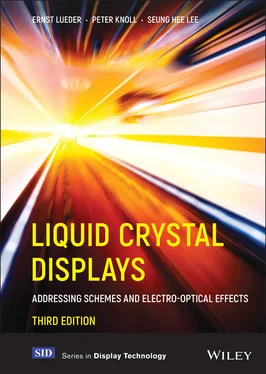Ernst Lueder - Liquid Crystal Displays
Здесь есть возможность читать онлайн «Ernst Lueder - Liquid Crystal Displays» — ознакомительный отрывок электронной книги совершенно бесплатно, а после прочтения отрывка купить полную версию. В некоторых случаях можно слушать аудио, скачать через торрент в формате fb2 и присутствует краткое содержание. Жанр: unrecognised, на английском языке. Описание произведения, (предисловие) а так же отзывы посетителей доступны на портале библиотеки ЛибКат.
- Название:Liquid Crystal Displays
- Автор:
- Жанр:
- Год:неизвестен
- ISBN:нет данных
- Рейтинг книги:4 / 5. Голосов: 1
-
Избранное:Добавить в избранное
- Отзывы:
-
Ваша оценка:
- 80
- 1
- 2
- 3
- 4
- 5
Liquid Crystal Displays: краткое содержание, описание и аннотация
Предлагаем к чтению аннотацию, описание, краткое содержание или предисловие (зависит от того, что написал сам автор книги «Liquid Crystal Displays»). Если вы не нашли необходимую информацию о книге — напишите в комментариях, мы постараемся отыскать её.
THE NEW EDITION OF THE GOLD-STANDARD IN TEACHING AND REFERENCING THE FUNDAMENTALS OF LCD TECHNOLOGIES
Liquid Crystal Displays — читать онлайн ознакомительный отрывок
Ниже представлен текст книги, разбитый по страницам. Система сохранения места последней прочитанной страницы, позволяет с удобством читать онлайн бесплатно книгу «Liquid Crystal Displays», без необходимости каждый раз заново искать на чём Вы остановились. Поставьте закладку, и сможете в любой момент перейти на страницу, на которой закончили чтение.
Интервал:
Закладка:
4 Chapter 5 Figure 5.1 The Poincaré sphere as a description of polarization Figure 5.2 The complex plane for χ and the pertinent polarizations Figure 5.3 Jones vector J with its complex components Jx and Jy and the unity vectors r and l for circular polarization
5 Chapter 6Figure 6.1 The direction of  and
and  of the ordinary beam and of
of the ordinary beam and of  and
and  of the extraordinary beam in a uniaxial LC mediumFigure 6.2 Cross-sections through the sphere of k 0and the ellipsoid of revolution of k efor (a) n 0> n e, (b) n 0< n eFigure 6.3 (a) The ellipsoid of revolution representing n fin Equation (6.30); (b) propagation of the extraordinary beam obliquely through LC moleculesFigure 6.4 Viewing direction defined by azimuth angle Φ and off-axis angle Θ eFigure 6.5 Curves of isocontrast and of limit for grey shade inversion of an LCDFigure 6.6 Grey level inversion versus Θ ein the picture of an LCDFigure 6.7 Optical retardation for oblique viewing angle Θ e≠ 0Figure 6.8 Compensation of retardation with a negative c-plateFigure 6.9 (a) A 10 : 1 isocontrast curve for an ECB cell with (ii) and without (i) a discotic compensation film (Haas, 1999); (b) the limit curves of grey inversion in an ECB cell with (ii) and without (i) a discotic filmFigure 6.10 Discotic films of half thickness on either side of the LCDFigure 6.11 Symmetrical curves for 10:1 isocontrast and for limit of grey inversion of cell in Figures 6.9(a) and 6.9(b)Figure 6.12 Compensation of the retardations of the midlayer and surface layer moleculesFigure 6.13 The compensation of retardations of an LCD by discotic films with the same direction of optical axesFigure 6.14 Isocontrast and limit for grey inversion after compensation with discotic films in Figure 6.13Figure 6.15 Double layer STN cell for compensation of black state and coloration and top view on slow and fast propagation axisFigure 6.16 The pairs of STN layers with opposite twist for compensation in Figure 6.15Figure 6.17 Viewing direction for minimum luminanceFigure 6.18 A pixel with four domainsFigure 6.19 The photo-induced alignment and adjustment of the tilt angle Θ of LC molecules on top of the orientation layerFigure 6.20 Principle of the in-plane switching modeFigure 6.21 Transmittance of various grey levels versus the off-axis Θ efor an IPS displayFigure 6.22 The self-compensation of the retardation R of light propagating at an oblique angle through the π -cell. (a) Light propagation in the direction of the cell normal; (b) propagation at an oblique angleFigure 6.23 Isocontrast curves of a π cellFigure 6.24 The generation of a torque at an LC molecule in an E -fieldFigure 6.25 (a) Molecules exposed to a fringe field. Determination of a torque T (b) for a molecule on the left side, and (c) on the right side of a fringe fieldFigure 6.26 Field of directors generated by a fringe field in Figure 6.25(a) forming two domainsFigure 6.27 (a) Field of directors in aVA cell with a large voltage applied; (b) proof of stability for the horizontal orientation of a molecule in the centreFigure 6.28 The ellipsoid of revolution located in the centre of a VA cell in Figure 6.27(a)Figure 6.29 Colour shift in the chromaticity diagram (CIE 1976)Figure 6.30 (a) The MVA cell with protrusions; (b) propagation of the LC alignment in an MVA cellFigure 6.31 (a) Patterned electrodes of a PVA cell; (b) director field below a common electrode of a PVA cell when voltage is appliedFigure 6.32 Colour shift in the x – y chromaticity diagram in Figure 19.5 for a TN cell ( d / p = 0.25) and a VA cell ( d / p = 0)Figure 6.33 Electrodes and director field of a PVA cell with two domains when a voltage is appliedFigure 6.34 V-shaped electrodes for a four-domain cellFigure 6.35 The division of a pixel into two subpixels with areas A and B (upper part of figure) and γ curves for the subpixels with different area ratios (lower part of figure). This figure was reproduced from Kim, S. S., SID 05 , p. 1842 with permission by The Society for Information DisplayFigure 6.36 The spread of the γ curve of an S-PVA display at various viewing angles. This figure was reproduced from Lee, S. W. et al ., SID 06 , p. 1591 with permission by The Society for Information DisplayFigure 6.37 Spread of the γ curve in the display of Figure 6.35 but with two subpixels. This figure was reproduced from Lee, S. W. et al., SID 06 , p. 1592 with permission by The Society for Information DisplayFigure 6.38 Colour shift (a) for on-axis view and (b) for 60° off-axis view in a PVA display with two subpixels. This figure was reproduced from Lee, S. W. et al., SID 06 , p. 1592 with permission by The Society for Information DisplayFigure 6.39 Achievable area for oblique angle γ curves. This figure was reproduced from Chen, C. Y. et al., SID 08 , p. 1120 with permission by The Society for Information DisplayFigure 6.40 The achieved γ curve for case (a) (type I) and for the mix-type case, where (a) and (b) are feasible. This figure was reproduced from Chen, C. Y. et al., SID 08 , p. 1120 with permission by The Society for Information DisplayFigure 6.41 Various pretilts and their direction of rotation after a voltage was applied. This figure was reproduced from Song, J. K., SID 04 , p. 1345 with permission by The Society for Information DisplayFigure 6.42 Fabrication process for the polymer layer in PSA cells. This figure was reproduced from Hanaoka, K. et al., SID 04 , p. 1200 with permission by The Society for Information DisplayFigure 6.43 The mountain shaped surface on the side of the colour filter. This figure was reproduced from Sohn, J. et al., SID 06 , p. 1063 with permission by The Society for Information DisplayFigure 6.44 The circular alignment of the LC molecules as a pinwheel. Adapted from Kubo, M. et al ., Sharp-world.com 2001, p. 2, Figure 1Figure 6.45 (a) Black stripes in the pixels before the addition of chiral components and (b) diminished black stripes after the addition of chiral components. Source: Kubo, M. et al ., Sharp-world.com 2001, p. 2, Photo 1 a,bFigure 6.46 The three-layer laminate of the 3M reflective polarizerFigure 6.47 Merck’s reflective polarizer based on a cholesteric filmFigure 6.48 The operation of Brightness Enhancement Film (BEF)Figure 6.49 Optical waveguidesFigure 6.50 The viewing cone of an optical waveguide
of the extraordinary beam in a uniaxial LC mediumFigure 6.2 Cross-sections through the sphere of k 0and the ellipsoid of revolution of k efor (a) n 0> n e, (b) n 0< n eFigure 6.3 (a) The ellipsoid of revolution representing n fin Equation (6.30); (b) propagation of the extraordinary beam obliquely through LC moleculesFigure 6.4 Viewing direction defined by azimuth angle Φ and off-axis angle Θ eFigure 6.5 Curves of isocontrast and of limit for grey shade inversion of an LCDFigure 6.6 Grey level inversion versus Θ ein the picture of an LCDFigure 6.7 Optical retardation for oblique viewing angle Θ e≠ 0Figure 6.8 Compensation of retardation with a negative c-plateFigure 6.9 (a) A 10 : 1 isocontrast curve for an ECB cell with (ii) and without (i) a discotic compensation film (Haas, 1999); (b) the limit curves of grey inversion in an ECB cell with (ii) and without (i) a discotic filmFigure 6.10 Discotic films of half thickness on either side of the LCDFigure 6.11 Symmetrical curves for 10:1 isocontrast and for limit of grey inversion of cell in Figures 6.9(a) and 6.9(b)Figure 6.12 Compensation of the retardations of the midlayer and surface layer moleculesFigure 6.13 The compensation of retardations of an LCD by discotic films with the same direction of optical axesFigure 6.14 Isocontrast and limit for grey inversion after compensation with discotic films in Figure 6.13Figure 6.15 Double layer STN cell for compensation of black state and coloration and top view on slow and fast propagation axisFigure 6.16 The pairs of STN layers with opposite twist for compensation in Figure 6.15Figure 6.17 Viewing direction for minimum luminanceFigure 6.18 A pixel with four domainsFigure 6.19 The photo-induced alignment and adjustment of the tilt angle Θ of LC molecules on top of the orientation layerFigure 6.20 Principle of the in-plane switching modeFigure 6.21 Transmittance of various grey levels versus the off-axis Θ efor an IPS displayFigure 6.22 The self-compensation of the retardation R of light propagating at an oblique angle through the π -cell. (a) Light propagation in the direction of the cell normal; (b) propagation at an oblique angleFigure 6.23 Isocontrast curves of a π cellFigure 6.24 The generation of a torque at an LC molecule in an E -fieldFigure 6.25 (a) Molecules exposed to a fringe field. Determination of a torque T (b) for a molecule on the left side, and (c) on the right side of a fringe fieldFigure 6.26 Field of directors generated by a fringe field in Figure 6.25(a) forming two domainsFigure 6.27 (a) Field of directors in aVA cell with a large voltage applied; (b) proof of stability for the horizontal orientation of a molecule in the centreFigure 6.28 The ellipsoid of revolution located in the centre of a VA cell in Figure 6.27(a)Figure 6.29 Colour shift in the chromaticity diagram (CIE 1976)Figure 6.30 (a) The MVA cell with protrusions; (b) propagation of the LC alignment in an MVA cellFigure 6.31 (a) Patterned electrodes of a PVA cell; (b) director field below a common electrode of a PVA cell when voltage is appliedFigure 6.32 Colour shift in the x – y chromaticity diagram in Figure 19.5 for a TN cell ( d / p = 0.25) and a VA cell ( d / p = 0)Figure 6.33 Electrodes and director field of a PVA cell with two domains when a voltage is appliedFigure 6.34 V-shaped electrodes for a four-domain cellFigure 6.35 The division of a pixel into two subpixels with areas A and B (upper part of figure) and γ curves for the subpixels with different area ratios (lower part of figure). This figure was reproduced from Kim, S. S., SID 05 , p. 1842 with permission by The Society for Information DisplayFigure 6.36 The spread of the γ curve of an S-PVA display at various viewing angles. This figure was reproduced from Lee, S. W. et al ., SID 06 , p. 1591 with permission by The Society for Information DisplayFigure 6.37 Spread of the γ curve in the display of Figure 6.35 but with two subpixels. This figure was reproduced from Lee, S. W. et al., SID 06 , p. 1592 with permission by The Society for Information DisplayFigure 6.38 Colour shift (a) for on-axis view and (b) for 60° off-axis view in a PVA display with two subpixels. This figure was reproduced from Lee, S. W. et al., SID 06 , p. 1592 with permission by The Society for Information DisplayFigure 6.39 Achievable area for oblique angle γ curves. This figure was reproduced from Chen, C. Y. et al., SID 08 , p. 1120 with permission by The Society for Information DisplayFigure 6.40 The achieved γ curve for case (a) (type I) and for the mix-type case, where (a) and (b) are feasible. This figure was reproduced from Chen, C. Y. et al., SID 08 , p. 1120 with permission by The Society for Information DisplayFigure 6.41 Various pretilts and their direction of rotation after a voltage was applied. This figure was reproduced from Song, J. K., SID 04 , p. 1345 with permission by The Society for Information DisplayFigure 6.42 Fabrication process for the polymer layer in PSA cells. This figure was reproduced from Hanaoka, K. et al., SID 04 , p. 1200 with permission by The Society for Information DisplayFigure 6.43 The mountain shaped surface on the side of the colour filter. This figure was reproduced from Sohn, J. et al., SID 06 , p. 1063 with permission by The Society for Information DisplayFigure 6.44 The circular alignment of the LC molecules as a pinwheel. Adapted from Kubo, M. et al ., Sharp-world.com 2001, p. 2, Figure 1Figure 6.45 (a) Black stripes in the pixels before the addition of chiral components and (b) diminished black stripes after the addition of chiral components. Source: Kubo, M. et al ., Sharp-world.com 2001, p. 2, Photo 1 a,bFigure 6.46 The three-layer laminate of the 3M reflective polarizerFigure 6.47 Merck’s reflective polarizer based on a cholesteric filmFigure 6.48 The operation of Brightness Enhancement Film (BEF)Figure 6.49 Optical waveguidesFigure 6.50 The viewing cone of an optical waveguide
6 Chapter 7Figure 7.1 The bipolar configuration of the LC molecules in a PDLC dropletFigure 7.2 Operation of a transmissive PDLC cell (a) in the off-state, and (b) in the on-stateFigure 7.3 Contrast ratio on screen versus power density of UV irradiation of a 10 μm thick PDLC cellFigure 7.4 Transmission versus voltage of a transmissive PDLC light valueFigure 7.5 The absorption of light by pleochroic dyesFigure 7.6 A reflective black and white PDLCD cell operating with ambient lightFigure 7.7 The Heilmeier Guest-Host cell (a) in the off-state, and (b) in the on-stateFigure 7.8 The Double Guest-Host cell with Δ ε > 0 (a) in the off-state and (b) in the on-state (Adapted from Uchida et al ., 1980)Figure 7.9 The Double Guest-Host cell with Δ ε < 0 (a) in the off-state and (b) in the on-state (Adapted from Uchida et al ., 1980)Figure 7.10 Absorbance versus voltage V LCof a pleochroic dye for maximum absorbance at λ = 582 nmFigure 7.11 Cholesteric nematic phase change Guest-Host Display with the axis of the helix parallel to the glass plates (a) in the off-state, and (b) in the on-stateFigure 7.12 Cholesteric nematic phase change Guest-Host Display with the axis of the helix perpendicular to the glass plates (a) in the off-state, and (b) in the on-stateFigure 7.13 A reflective black and white PC-GHDFigure 7.14 Reflectance of a PC-GH LCD versus wavelengthFigure 7.15 A single cell DGH display with a plastic separation layerFigure 7.16 A GH display with a conventional colour filter for R, G and BFigure 7.17 Transmission spectra (a) of the primary colours R, G and B, and (b) of the complementary colours yellow, magenta and cyanFigure 7.18 Structure of a stacked three-layer PC-GH displayFigure 7.19 The three-layer GH display with stacked films of encapsulated liquid crystals
Читать дальшеИнтервал:
Закладка:
Похожие книги на «Liquid Crystal Displays»
Представляем Вашему вниманию похожие книги на «Liquid Crystal Displays» списком для выбора. Мы отобрали схожую по названию и смыслу литературу в надежде предоставить читателям больше вариантов отыскать новые, интересные, ещё непрочитанные произведения.
Обсуждение, отзывы о книге «Liquid Crystal Displays» и просто собственные мнения читателей. Оставьте ваши комментарии, напишите, что Вы думаете о произведении, его смысле или главных героях. Укажите что конкретно понравилось, а что нет, и почему Вы так считаете.












